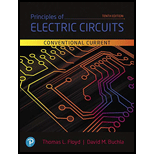
EBK PRINCIPLES OF ELECTRIC CIRCUITS
10th Edition
ISBN: 9780134880068
Author: Buchla
Publisher: VST
expand_more
expand_more
format_list_bulleted
Concept explainers
Question
error_outline
This textbook solution is under construction.
Students have asked these similar questions
Fundimentals of Energy Systems Q2
Fundimentals of Energy Systems Q3
Fundimentals of Energy Systems Q5
Knowledge Booster
Learn more about
Need a deep-dive on the concept behind this application? Look no further. Learn more about this topic, electrical-engineering and related others by exploring similar questions and additional content below.Similar questions
- * 7.29 The current source in the circuit of Fig. P7.29 is given by is(t) = 12 cos(2л × 10¹t — 60°) mA. - Apply the phasor-domain analysis technique to determine ic(t), given that R= 20 2 and C = 1 μF.arrow_forwardPROBLEMS 7.33 Find ia(t) in the circuit of Fig. P7.33, given that Us(t) = 40 sin(200t -20°) V.arrow_forward7.25 Determine the impedances of the following elements: (a) R 1 k at 1 MHz = (b) L= 30 μH at 1 MHz *(c) C = 50 μF at 1 kHzarrow_forward
- DO NOT USE CHATGPT NEED HANDWRITTEN SOLUTIONarrow_forwardCheck the suitability of the cable cross sections with voltage drop calculation and current control methods. If they are not suitable, determine the suitable cable cross section by using given table. %e₁ 6mm² 25m AT KT1A %e2 %e3 6mm² 2,5mm² 15m 10m 15000W 7500W 2500W Num, of Cores Number of Thickness of Thickness of and Nominal Wires and Cross Section Diameter Insulation Overall Diameters in Approx Sheath Standards Overall Diameter Nox mm² Nox mm mm mm min max max. mm 2x0,75 22x0,20 0,6 0,80 5,7 7,2 6,4 2x1 30x0,20 0,6 0,80 5,9 7,5 6,6 2x1,5 27x0,25 0,7 0,80 6,8 8,6 7,4 2x2,5 45x0,25 0.8 1,00 8,4 10,6 9.2 2x4 50x0,30 0,8 1,10 9,7 12,1 11 2x6 75x0,30 0,8 1,10 11,8 13,1 12,4 2x10 73x0,40 0,9 1,20 14.6 15,8 15 3x0,75 22x0,20 0,6 0,80 6 7,6 6,8 3x1 30x0,20 0,6 0,80 6,3 8 7 3x1,5 27x0,25 0,7 0,90 7A 9,4 8,1 3x2,5 45x0,25 0,8 1,10 9,2 11,4 10 3x4 50x0,30 0,8 1,20 10,5 13,1 11,9 3x6 75x0,30 0.8 1,10 12,5 14,2 13,3 3x10 73x0,40 0,9 1,20 15,8 17,2 16,3 4x0,75 22x0,20 0,6 0,80 6,6 8,3 7,4 4x1…arrow_forwardDon't use ai to answer I will report you answer.arrow_forward
- I need explanation to this, break It down This is control theory engineeringarrow_forwardDon't use ai to answer I will report you answerarrow_forwardDO NOT USE CHATGPT OR AI The current through the 2.0 ohm resistor is 1.91 A entering the node. Determine the currents in the 4.0ohm and 1.5 ohm resistors. Ans: I1=2.21A I3=4.12Aarrow_forward
arrow_back_ios
SEE MORE QUESTIONS
arrow_forward_ios
Recommended textbooks for you
 Delmar's Standard Textbook Of ElectricityElectrical EngineeringISBN:9781337900348Author:Stephen L. HermanPublisher:Cengage Learning
Delmar's Standard Textbook Of ElectricityElectrical EngineeringISBN:9781337900348Author:Stephen L. HermanPublisher:Cengage Learning Electricity for Refrigeration, Heating, and Air C...Mechanical EngineeringISBN:9781337399128Author:Russell E. SmithPublisher:Cengage Learning
Electricity for Refrigeration, Heating, and Air C...Mechanical EngineeringISBN:9781337399128Author:Russell E. SmithPublisher:Cengage Learning

Delmar's Standard Textbook Of Electricity
Electrical Engineering
ISBN:9781337900348
Author:Stephen L. Herman
Publisher:Cengage Learning

Electricity for Refrigeration, Heating, and Air C...
Mechanical Engineering
ISBN:9781337399128
Author:Russell E. Smith
Publisher:Cengage Learning
What is an electric furnace and how does it work?; Author: Fire & Ice Heating and Air Conditioning Inc;https://www.youtube.com/watch?v=wjAWecPGi0M;License: Standard Youtube License